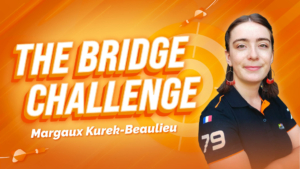
The Invincible Zia tournament analysis – June
Named ACBL player of the year many times,world champion and member of the Hall of Fame, Zia Mahmood gives you a hard time every month during Funbridge Points Tournament!
Discover 3 deals analysed by Zia Mahmood from his June tournament.

Deal 12
 |
| West | North Zia (auction) | East | South Zia (play) |
| PASS | |||
| PASS | PASS | PASS | |
| PASS |
Contract: 3 NT by South. Lead: ♥ Q
I ducked West’s opening lead of ♥ Q and the robot shifted to a club. Winning with the ace East returned a heart, and West cashed two more of those to hold me to nine tricks for pretty much a complete bottom, since after the lead I had started with ten in top cards.
Those are the simple facts of the matter, but the reasons for my actions may not be completely obvious to you. They’re painful for me to record, but of course I must be honest with my readers. You see, one of the features of Funbridge is that when your side wins the auction you are automatically moved to the seat at the bottom of the screen to play the hand, so that it seems you are South wherever you actually sat during the bidding.
I started life as North on this hand, but by the time I got flip-flopped to the South seat to play 3 NT I had forgotten that the Michaels bidder was now to my left – during the bidding it had been to my right.
You may wonder why this matters – I still had ten top tricks. But I had a devious plan. West had obviously led a heart from something like ♥ Q x, maybe even ♥ Q J x. If I ducked, the defenders would continue hearts and I would make eleven tricks for a top score.
So much for devious plans. But I couldn’t help wondering – had I fallen victim to a new kind of dummy reversal?
Deal 14
 |
| West | North (Zia) | East | South |
| PASS | PASS | ||
| PASS | PASS | ||
| PASS | PASS | ||
| PASS |
Contract: 6 ♣ by South. Lead: ♥ 5
After the normal start of 1 ♣ by partner, 1 ♠ by me and 2 NT by the robot, I had a choice – I could show club support with 3 ♣ or simply check for spade support with 3 ♦, an artificial enquiry. It seemed to me that 3 ♣ might work better – if we had a fit in both black suits my partner would be well placed later in the bidding.
The robot bid 3 ♠, and I happily raised to four. When I looked back at the screen, instead of seeing an opening lead from the robot to my left I saw a bid of 5 ♣ from the robot opposite. Clearly the circuitry had thought that 4 ♠ was some sort of control bid with clubs agreed as trump.
Still, my hand was good for a club contract, which was why I had bid 3 ♣ in the first place. But one thing was for sure: 4 ♠ was almost certain to make and almost certain to score better than 5 ♣ when it did. I thought about retreating to 5 ♠, but partner’s electronic brain had obviously blown a diode and I didn’t want it thinking this was some sort of grand slam try in clubs.
So I bid 6 ♣ and was once again whisked to the South seat as declarer. Even though West found the best lead of a heart I could manage the play, and was relieved to emerge with a very fine match point score.
Deal 7
 |
| West | North (Zia) | East | South |
| PASS | |||
| PASS | PASS | ||
| PASS | PASS | ||
| PASS | PASS | ||
| PASS | PASS | PASS | |
| PASS |
Contract: 7 NT by South. Lead: ♠ Q
On Funbridge you can see what the robot thinks your bids and its bids mean, so I will give you the explanation from both our points of view.
2 ♣ showed a good hand. After this promising start, our paths diverged.
I would rarely respond 2 NT whatever I had. but the robot saw no harm in it because it had at least eight points and that was what 2NT showed.
I bid my clubs and the robot supported them. Personally I’d have shown diamonds, because AQJ10x is something a 2 ♣ opener might want to hear about – but in fairness it did have a good supporting hand for clubs.
I bid what I hoped was Blackwood and the robot showed an ace.
Now I could count eleven tricks opposite just ♦ A, and the robot would have more than that. The trouble was, I didn’t know how much more – if it had the red queens, or one of them and ♠ K, a grand slam would be cold. But it could have the spade queen and only one of the red ones, when there might be no play for 7 NT. I decided to try 5 ♠, ostensibly a transfer to 5 NT, and then make some form of cultured grand slam try.
But when the robot dutifully bid 5 NT I realized that I didn’t know what cultured try to make. So I made an uncultured one, and a few seconds later I claimed fourteen tricks. This was a pretty good score, but perhaps other pairs did not have the advantages of our beautiful system.



